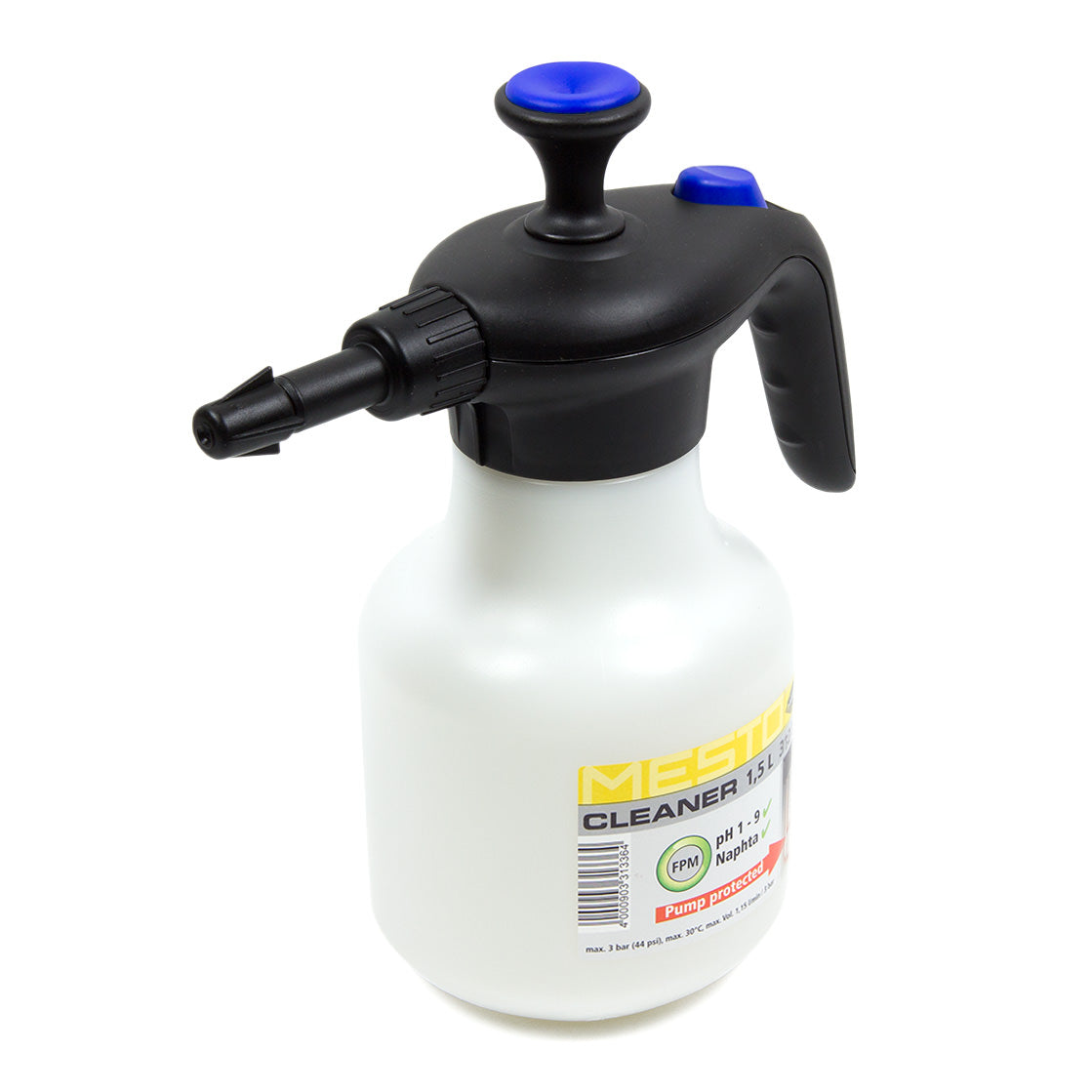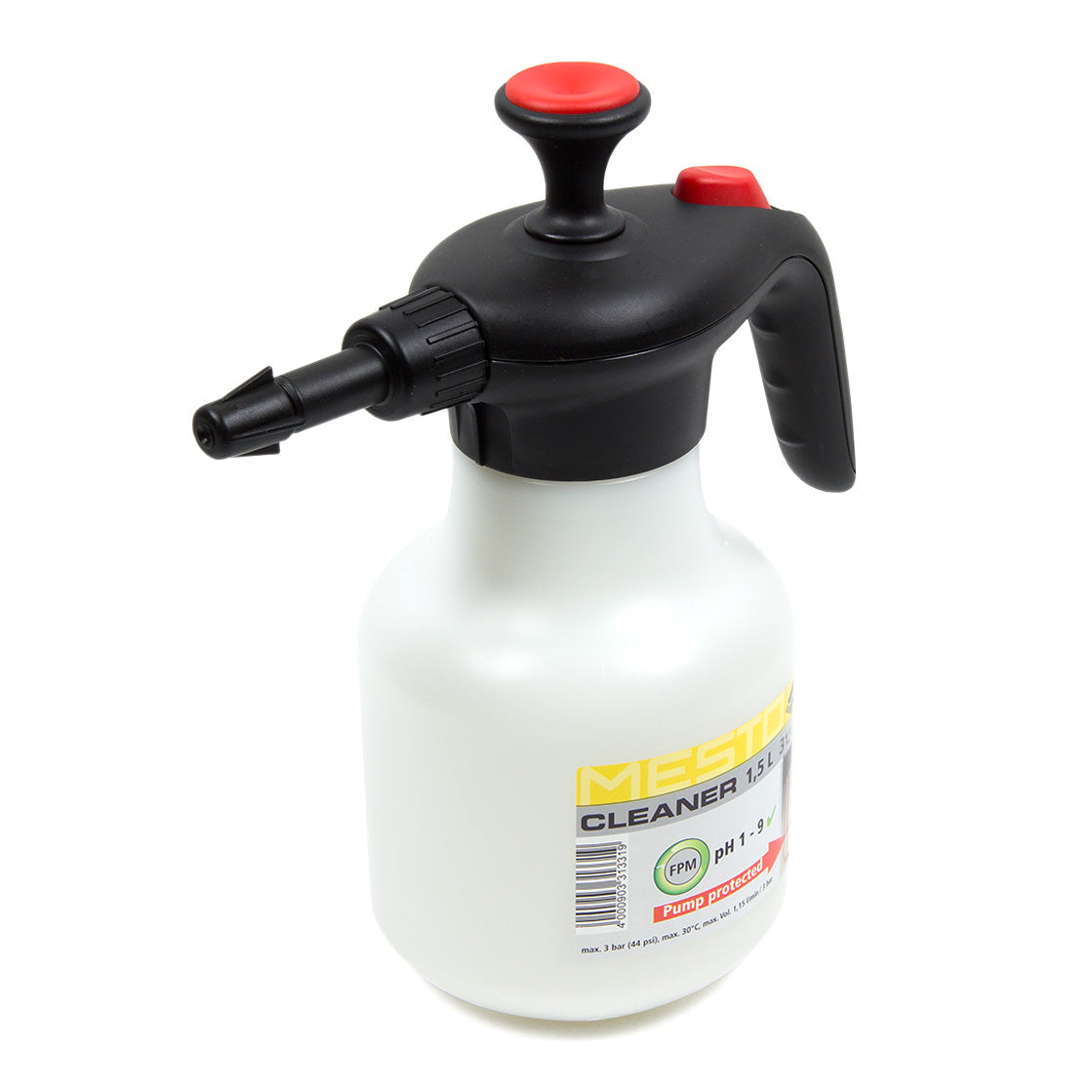

We Say
Take a moment to think about how you typically apply cleaning chemicals when you detail your car; it's probably via plastic bottles fitted with trigger-style spray heads. Now picture in your mind how well this method works and consider the following statements. Wouldn't it be good if you could apply cleaning products more evenly, and more sparingly, thus improving their performance and saving you money? Wouldn't it be good if you could avoid hand and finger cramp when spending long periods of time spraying chemicals, such as during the decontamination process? And wouldn't it be good if the seals in your spray heads lasted a lot longer before failing, and could actually be replaced? If you agree with any or all of these statements, then the MESTO CLEANER Pressure Sprayer deserves your attention. Designed and manufactured in Germany, by a family-owned business with nearly a century of expertise in developing and producing high quality portable sprayers, it offers all of the above-mentioned features and benefits. In the past, we persevered with bottles and spray heads for far too long; only when we tested the MESTO CLEANER Pressure Sprayer did we realise what we'd been missing out on. We urge you not to make the same mistake as us!
Key Features
Adjustable Spray PatternYes(Variable Arc)
Capacity1.5 L(To Maximum Fill Line)
Chemically ResistantYes(Tolerates Strong Chemicals)
Description
The MESTO CLEANER Pressure Sprayer is manufactured in Germany, and is designed to enable all types of cleaning chemicals to be applied more efficiently, in terms of speeding up the rate of coverage and minimising the amount of product used. The MESTO CLEANER Pressure Sprayer features a high-density polyethylene (HDPE) tank, which is chemically resistant and clearly graduated, and a chemically resistant pump with an exchangeable spray lance and a built-in pressure release valve. The spray lance itself features an adjustable nozzle, which varies the spray pattern and degree of atomisation. Three different versions of the MESTO CLEANER Pressure Sprayer are available (with varying seal and pump materials) to cater for the three different categories of cleaning chemicals used in modern car care. The base resistant version (suitable for detergent-based cleaners, pH 7-14) features ethylene propylene diene monomer (EPDM) rubber seals and a polypropylene (PP) pump. The acid resistant version (suitable for acid-based cleaners, pH 1-7) features fluoro-rubber (FPM) seals and a polypropylene (PP) pump. The naphtha resistant model (suitable for spirit- and d-Limonene-based cleaners) features fluoro-rubber (FPM) seals and a polyamide (PA) pump.
Specification
| Adjustable Spray Pattern | Yes |
|---|---|
| Capacity | 1.5 L |
| Chemically Resistant | Yes |
| Construction | High-density polyethylene tank and polypropylene or polyamide pump |
| Promo Offer | BUY 3 OR MORE SAVE 5% |
How To Use
Assemble according to the supplied instructions, making sure that all of the connections are nipped up tightly enough to form a leak-free seal, but not so tight as to damage the plastic threads. To ready the sprayer for use, turn the pressure release valve on the side of the pump until any residual pressure is released. Then unscrew the pump and fill the tank with a suitably diluted cleaning solution up to the filling line (we provide recommended dilution ratios for all of the cleaning solutions we stock; see the Specification section on the relevant product pages for details). Finally, screw the pump on to the tank and pressurise the system (using 30-40 pump strokes). To spray the cleaning solution, press the button atop the handle on the pump; releasing the button stops the spraying action immediately. The spray pattern can be adjusted by turning the nozzle where the spray emerges. After use, depressurise the system using the pressure release valve on the side of the pump; never leave the system pressurised while in storage, and never depressurise the system by unscrewing the pump from the tank.
Notes on dilution:
Making up diluted solutions is a relatively easy task, but it's worth noting that some confusion can arise from differences in the way that car care product manufacturers quote dilution ratios. Strictly speaking, dilution ratios should be quoted as the number of parts of original chemical in the total number of parts of diluted solution. Accordingly, a dilution ratio of 1:10 would be achieved by making up a solution containing one part neat chemical and nine parts water, i.e. ten parts in total (giving a dilution ratio of one in ten). However, it's far more common for manufacturers to quote dilution ratios in parts dilutant to parts original chemical. Accordingly, a dilution ratio of 10:1 would be achieved by making up a solution containing ten parts water and one part neat chemical, i.e. eleven parts in total (giving a dilution ratio of ten to one). It contrast to the strict definition, this produces a slightly weaker solution, and for this reason we recommend that this latter interpretation is adopted whenever doubt about the ratio arises, as it's far safer to work with a solution that's too weak rather than one that's too strong.
Notes on dilution:
Making up diluted solutions is a relatively easy task, but it's worth noting that some confusion can arise from differences in the way that car care product manufacturers quote dilution ratios. Strictly speaking, dilution ratios should be quoted as the number of parts of original chemical in the total number of parts of diluted solution. Accordingly, a dilution ratio of 1:10 would be achieved by making up a solution containing one part neat chemical and nine parts water, i.e. ten parts in total (giving a dilution ratio of one in ten). However, it's far more common for manufacturers to quote dilution ratios in parts dilutant to parts original chemical. Accordingly, a dilution ratio of 10:1 would be achieved by making up a solution containing ten parts water and one part neat chemical, i.e. eleven parts in total (giving a dilution ratio of ten to one). It contrast to the strict definition, this produces a slightly weaker solution, and for this reason we recommend that this latter interpretation is adopted whenever doubt about the ratio arises, as it's far safer to work with a solution that's too weak rather than one that's too strong.



